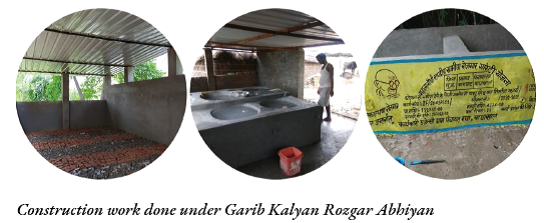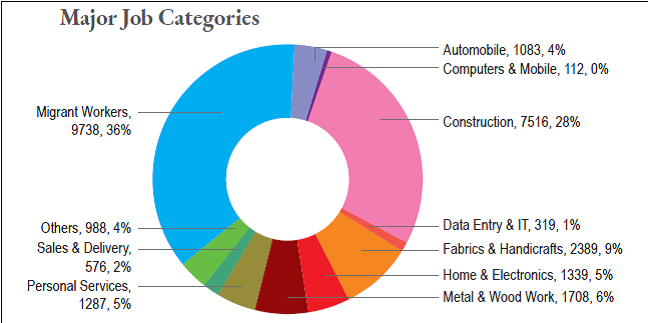Employment Generation and Livelihood Promotion in Muzaffarpur District
Employment Generation and Livelihood Promotion in Muzaffarpur District
Muzaffarpur District undertook various activities and initiatives-plantation drives, rain-water harvesting, soak-pit construction, rejuvenation of wells, construction of community toilets, anganwadi constructions and upgradation of infrastructure, upgradation and construction of Panchayat Sarkar Bhawan, cattle-and goat-shed constructions, solid and liquid waste management under the Lohiya Swachh Bharat Abhiyaan-to employ returned migrants.
Under the Bihar government’s Zila Audyogik Nav Parivartan Yojana and Mukhyamantri Kushal Shramik Udyami Cluster Yojana, seven clusters were identified to be set up at various blocks. As per the skill mapping done, these clusters have been developed for employment generation by setting up a readymade garment manufacturing unit, sweets packaging boxes unit, lahthi (lac bangle) park, mobile charger assembling unit, and paver blocks manufacturing unit. Each cluster started with 25–30 members and grew to provide employment to 200–300 people. The cluster and deputy heads, and accounts lead were elected amongst the group members through meetings. These clusters are registered as Limited Liability Partnership entities to ensure sustainability and proper workflow.

The Muzaffarpur District Administration-with the support of Bihar Rural Livelihoods Promotion Society or Jeevika-is also focused on providing maximum support to small scale businesses under its jurisdiction, there by making people more self-reliant and improving the living standards of migrants who have returned home.
Mission Employment Aurangabad
As many as 27,322 migrants returned to Aurangabad District during the Covid-19 pandemic. To ensure livelihood opportunities, the district administration constituted a project team called Mission Employment Aurangabad.
Under this framework, an initial situation analysis was carried out to understand the needs and requirements of the migrants. Subsequently, the district administration took up registration and skill mapping. Following this, output- and outcome-based targets were set to provide employment opportunities according to skill sets.
Skill Mapping and Job Standardization
The migrants registered themselves under more than fifty job roles, grouped under eleven major categories:

Job Mela
Based on job profiles and initial surveys regarding job demands, the GM District Industries Centre organized a job mela on 11 June 2020, where only local companies and job roles were offered. A total of thirty companies from the district took part, looking for suitable candidates, and offering salary in the range of Rs 6,000–18,000.
Livelihood Projects
The Aurangabad District Administration is also developing five livelihood projects—after conducting a background analysis—with a total investment of Rs 50 lakh—Rs 10 lakh for each project—to provide more employment opportunities and boost the local economy. The task has been assigned to consultants placed by the Ministry of Home Affairs under the Aspirational Districts Programme. Currently, various farmers’ and self-help groups are being interviewed to understand the most preferred livelihood options that can be taken up using local resources. Initial survey results revealed agriculture to be the top category, with more than 70% of Aurangabad’s population engaged in it. Handicrafts and handlooms have been identified as the second most preferable sector, with carpet-making a major craft practised in the district for centuries. Given the prevalence of forest-based activities in the district, the production of eco-friendly goods is another potential income-generating area. Business plans will be developed for the same to ensure that the developed industries can sustain for a long period of time.
Garib Kalyan Rojgar Yojana
Under the Garib Kalyan Rojgar Yojana, the district received a target of providing 25,13,348 employment-generating days. As much as Rs 89.82 crore has been spent to create infrastructure ranging from Pradhan Mantri Gram Sadak Yojana roads, Pradhan Mantri Awas Yojana houses, community sanitary complexes, water conservation and harvesting works, farm ponds, cattle sheds, etc.
Source : Empowering Migrant Workers through Skill Development and Livelihood Generation
Last Modified : 9/14/2023
This topic provides information about Overview of ...
This topic provides information about Model School...
This topic provides information about Narmada Tran...
This topic provides information regarding Transfor...
